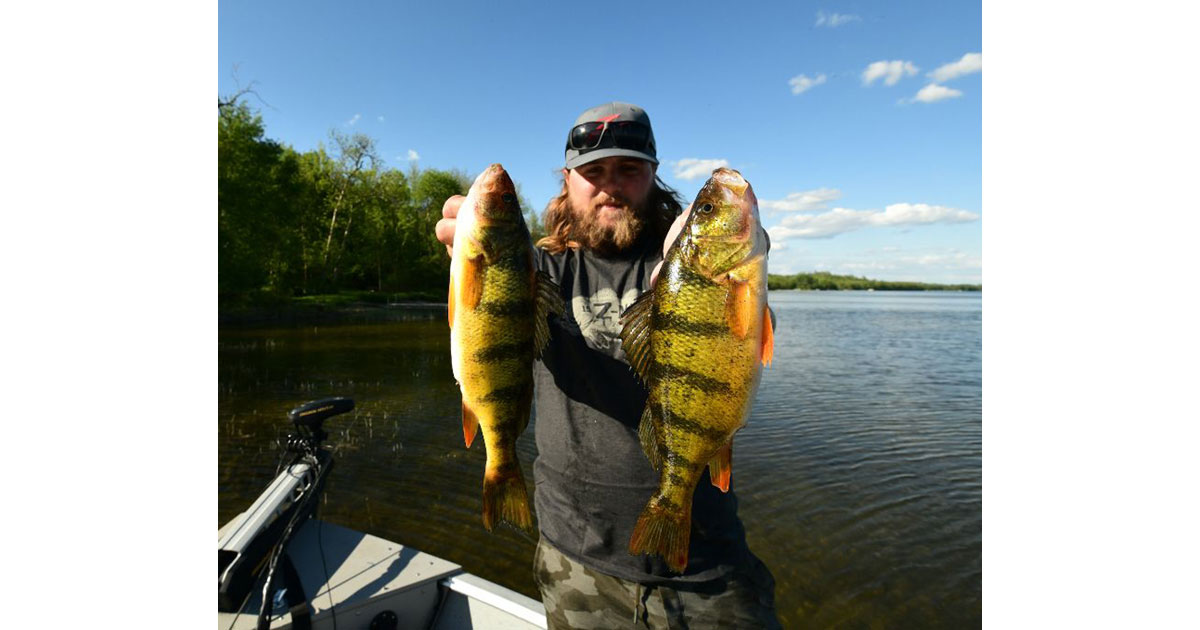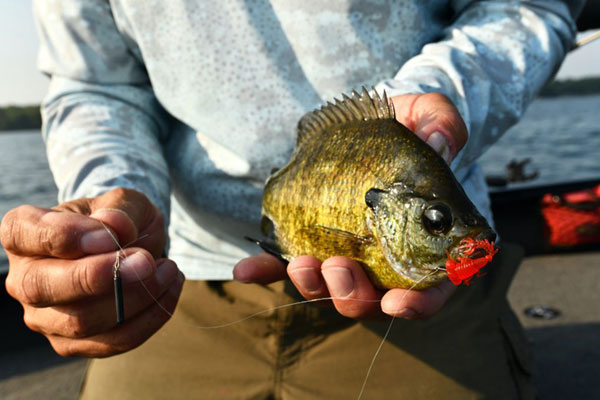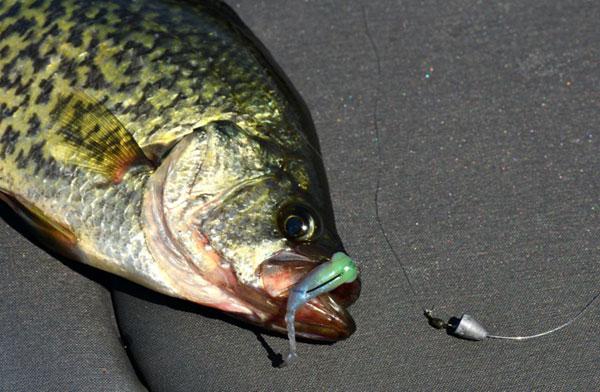Z-Man Report
 Yellow Perch
Yellow Perch
Sometimes, it pays to pitch for panfish as if they’re merely miniaturized versions of their larger bass brethren. In a way, they are. As members of the (Centrarchidae) sunfish family, species like bluegills, crappies and bass, in fact, all share a common pedigree.
The connection is even closer than anglers realize, as each of these species regularly co-mingle around the same aquatic turf, feasting upon the very same prey. Crayfish, insect larvae and tiny shad and shiners all whet the appetites of these communal predators. Bass and big bluegills frequently stalk the same rock-strewn turf, nosing around in little nooks and crevices for concealed crayfish, or larval insects clinging to the hard cover. Same deal on boat docks.
Whether close to cover or cherry-picking emerging insects in the abyss, panfish frequently feed up and off bottom, leaning on their nearsighted talents to inspect potential prey, eye-to-eye.
Offering all the depth precision of a slip bobber or float rig, yet with the added ability to traverse the bottom terrain, micro-sized finesse rigs remain among the deadliest yet most overlooked panfish presentations of all. But accomplishing the valuable “hover” portion of the presentation relies solely on a new generation of specialized superplastics—exceedingly soft and lively, impossibly durable and perhaps most important, naturally buoyant.
Micro “Hover” Rigs
 Panfish Drop-shot
Panfish Drop-shot
Consider the value of a micro finesse dropshot, Carolina or Cherry (aka Tokyo) rig, coupled with a softbait that floats and hovers naturally in the water column. Often, panfish graze insatiably on emerging insect larvae that hatch out of soft bottom. In other waters, crappies and sunfish crunch crayfish and bugs, such as dragonfly larva, clinging to the upper branches of aquatic plants, vertical dock pilings, or tangles of brush.
In each of these fish-attracting scenarios, a Z-Man LarvaZ™, StingerZ™ or Baby BallerZ™ rigged on a dropshot soars at a set depth, continuously. The natural buoyancy of this specialized ElaZtech material offers ample loft to float the hook itself, tirelessly hovering and twitching nervously, right in the fish’s strike zone. Little tics of the rodtip make the bait’s tail kick, dance and undulate in place, mimicking the exact movements of a live larva. The durable nature of the softbait material keeps the bait on the hook and won’t tear, even if you merely impale it once through the nose with a #8 to #14 hook. Or thread it onto the hook shank for a more horizontal posture while maintaining complete tail motion.
If sonar shows fish staged two feet off bottom, rig the dropshot with the hook riding 2-1/2 to 3 feet off bottom. Most panfish enthusiastically swim up to feed, so always better to keep your bait at eye level or a foot or two above. When fish gather closer to the substrate, switch to a shortened dropshot or “Cherry” rig, pinning the bait/hook within inches of the bottom. Once again, the buoyancy of the ElaZtech material keeps the bait hovering right at the fish’s eye level and out of soft mucky bottoms, where a traditional soft plastic will descend and disappear.
As noted, tail-kicking microbaits like the LarvaZ and StingerZ shine for moving slowly around smaller areas where fish gather. For covering more water or for imitating faster moving baitfish, switch to a micro finesse swimbait like the Shad FryZ™ and drag the rig slightly faster across the terrain. Moreover, the versatile Micro GOAT™ imitates both a crayfish or a baitfish. Rigged flat and retrieved with a slower, rod-twitching cadence, the Micro GOAT resembles a crayfish. But arranged on the hook vertically and retrieved faster, the GOAT’s twin tails become a double tail swimbait with an alluring scissor-kick action.
The Crappie Carolina
 Panfish Carolina rig
Panfish Carolina rig
For canvassing more water, especially around vegetation or channel ledges with brush and wood, consider converting from a slower moving dropshot to a more weedless Carolina, tethered to a 1/16- to 1/4-ounce bullet sinker. To match leader length to fish position or the height of underwater grass. When in doubt, start with a 1-foot leader of 4- to 6-pound test monofilament, which floats, and go from there.
The often-forgotten Carolina enables faster retrieves with little swimbaits like the Shad FryZ or Micro GOAT. But when you pause, the bait emerges and hovers in place, where its visibility offers an easy meal. Longer leaders allow baits to ascend higher. It’s almost like fishing livebait, the little ElaZtech morsel hovering and trembling in place, almost all by itself.
Finally, consider that micro rigging with buoyant softbaits let you easily follow their position and trajectory on forward facing sonar. So long as the bait hovers above bottom, you can clearly watch it on screen as fish examine and eat.
Stealth Rig Tackle
Often, the only way to match 1- to 2-inch microbaits with the right hooks is to delve into fly-tying tackle. Realistically, you need a light-wire #8 to #14 hook to work with rather than against the wispy, buoyant qualities of micro softbaits. Choice short-shank hooks for micro dropshot rigging include a #8 or #12 Mustad Heritage Caddis Fly or #10 to #14 Gamakatsu C13U hook.
Especially exciting for microbait/multispecies enthusiasts is the rise of specialized BFS (bait finesse system) tackle, much of it from Japanese manufacturers. BFS tackle opens whole other avenues of possibility for panfish enthusiasts, including the ability to cast tiny baits with extreme accuracy with miniaturized baitcasting gear. Check baitfinesseempire.com for perhaps the best selection of baits, hooks and micro finesse tackle.
Consider ultra-fine wire EWG style hooks (e.g. Varivas Fishing Nogales Inch Hook) in two sizes that match 1- to 2-inch softbaits—perfect for “Texpose” rigging a tiny Z-Man LarvaZ or Baby BallerZ. For working around brushpiles and through vegetation on a snag-resistant micro-Carolina rig alone, these tiny offset hooks open whole new dimensions of multispecies panfish angling.
For anchoring micro dropshots, if you’re not into spending big bucks for tungsten, one sinker alternative is to simply pinch a single BB (1/64-oz) to #3 (1/10-oz) split-shot onto the tagline. Best to “stop” the sinker with a simple overhand knot, tied below. Note: As a fish attractor, a dense tungsten sinker knocking rocks and sand can add audio appeal to your rig; bluegills and perch are especially curious about sound.
Most of these rigs should be tied with 4- to 8-pound test monofilament rather than fluorocarbon. Mono floats and matches the buoyancy of ElaZtech superplastics, while fluoro sinks and detracts from the presentation. For tying your own dropshot or Cherry rigs, use what’s become known as a dropshot knot. Search the web and you’ll find clear instructions on tying this incredibly simple, superior knot. It’s both easier to tie than the traditional Palomar and positions the hook perpetually perpendicular to the dropper, keeping your bait perfectly aligned. Add a tiny #14 ant swivel 12-to 18-inches or more up the line, to negate line twist and allow for quick rig changes.